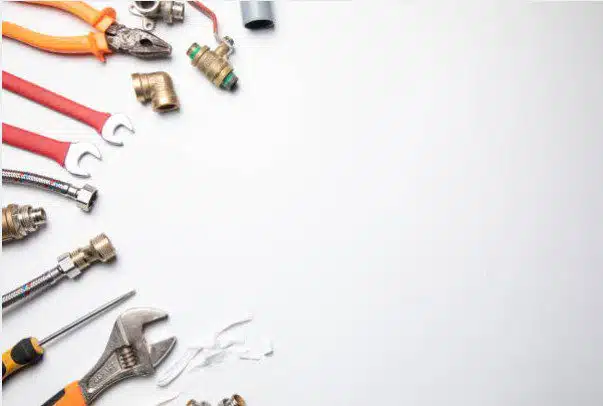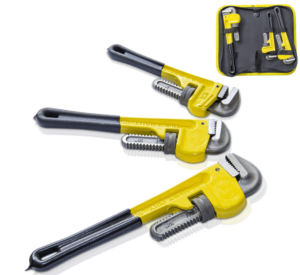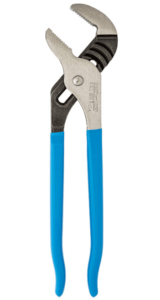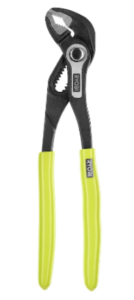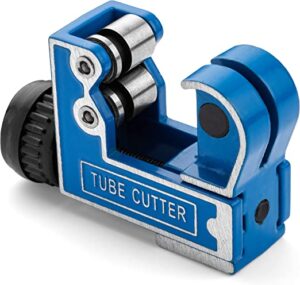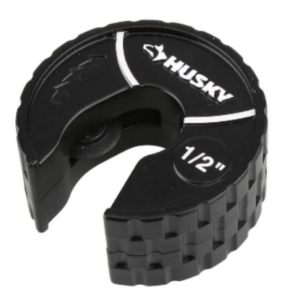There are many different kinds of plumbing pipes in every house. Even if you aren’t a trained plumber, you’ll still have to deal with a plumbing problem at some point. Some basic plumbing issues, like a clogged toilet or a dripping faucet, are simple fixes if you have the correct tools. In this article, we’ll show you 12 essential plumbing tools that you should have at home.
Essential Plumbing Tools Every Homeowner Needs
1. Pipe Wrench
A pipe wrench is one of the most essential plumbing tools that’s specifically designed for working with pipes.
Threaded pipe, typically made of galvanized steel, black iron, or a comparable metal, is the most common application for pipe wrenches. When a pipe wrench is tightened, its two serrated jaws dig into the pipe, providing a secure grip.
The pipe size can be adjusted by moving the top serrated jaw up and down. The teeth on a pipe wrench only grasp in one direction of rotation (as described above), making it function almost like a ratchet wrench.
The nut or bolt in the pipe is held in place by the wrench’s head. When you need to tighten or loosen a fastener, you’ll grip the wrench by its handle. The head of any fastener can be firmly grasped by any wrench. As soon as the wrench’s head secures a hold on the fastener, you can turn it to snug up or loosen the nut.
You can check out this 3 Pack Heavy Duty Pipe Wrench Set on Amazon for only $30.99. This high-quality three-piece wrench set features a variety of sizes (8″, 10″, and 12″), as well as a convenient carrying box. This adjustable wrench set is perfect for fixing gas tanks, plumbing in homes, and cars, among other tasks that call for a firm grip on a pipe.
If you’re not a fan of set tools, you can try the SupaTool Pipe Wrench at Walmart for $52.99. At the time of writing, they have a 39% discount offer, bringing down the price to $32.70.
2. Basin Wrench
Nearly every licensed plumber carries a basin wrench, which is why it’s also essential to have them in your home. The tool’s sole purpose is to make replacing or removing a sink’s faucet easier than before. As soon as you master its use, it will become an integral component of your plumbing toolbox.
Changing a faucet can be a challenge because there is rarely enough area beneath the sink to fit an adjustable wrench or even pliers. Using a basin wrench, you can quickly and easily loosen the nuts holding the sink’s faucet in place.
A basin wrench can be used to reach up and under the faucet and loosen the attachment nuts once the water supply has been turned off and the supply lines have been removed from the bottom of the faucet using an adjustable wrench. Basin wrenches have sharpened, serrated teeth that can grab and spin even the rustiest, rusted nuts.
The assembly can be removed from the sink by loosening the nuts holding it together. The plumber can then quickly repair or replace the fixture as needed. It is advised that new fastening nuts be used when repairing or replacing an original faucet. To prevent the nut from sticking and facilitate its future removal, several faucet manufacturers advise applying a little amount of anti-seize to the threads before installing a new faucet.
3. Adjustable Wrench
Adjustable wrenches are designed to accommodate a wide range of hexagonal nuts thanks to their variable settings. The adjustable wrench is often regarded as one of the most flexible tools available. These wrenches can be used on a considerably wider range of nut sizes than regular wrenches, which are often only useful for a specific size.
Finding the right wrench for the job can often be a question of trial and error. However, many people who do not regularly work with hand tools rarely get it right the first time. Some wrenches and nuts are made with English measurements, whereas others are made with metric. This wrench eliminates the need for matches.
Find the bolt or nut that has to be tightened. The adjustable wrench can be opened by turning a screw. The wrench’s jaw will open as a result. See if the nut fits into the gap you’ve created, or if you need to open it up some further. Be sure the opening is slightly larger than the nut.
Simply slide the open jaw over the nut to secure it. Tighten the screw mechanism until it grips the nut firmly. Then, tighten it by turning the wrench clockwise, or loosen it by turning it counterclockwise. Turn it until the nut is either free enough to be removed or too tight to turn. Finally, remove the wrench by unscrewing the mechanism.
4. Tongue-and-Grove Pliers
Flat, square, round, or hexagonal objects can be held securely in place with the help of tongue and groove pliers. The jaws can be adjusted to one of five different settings by sliding the curved ridge into the appropriate groove. Long-handled, heavy-duty tongue-and-groove pliers are frequently employed for holding pipes. When compared to slip-joint pliers, these have more stable jaws that provide a firmer hold.
Clamping materials, rotating nuts and bolts, and gripping oddly shaped objects are just some of the many popular uses for tongue-and-groove pliers. Objects can be rotated in place without moving them.
Check out this Channellock 440 12-Inch Tongue and Groove Plier on Amazon for only $27.49. It has stronger, more reliable gripping thanks to undercut channels that interlock in the steel construction. Tough, laser heat-treated, 90-degree teeth provide a secure hold in any direction and can withstand repeated use.
For a cheaper alternative, you can check out the RYOBI 8″ Quick Adjust Tongue and Groove Plier on Home Depot for only $19.88. They don’t offer this tool in-store, so don’t miss it. Its quick adjust feature allows fast adjustments to the ideal position.
5. Plungers
When it comes to clearing a clogged drain, plungers are the most essential plumbing tools for the average homeowner. But did you know that not all clogs require the same kind of plunger? Sink plungers, toilet (or flange) plungers, and accordion plungers are the three primary types of plungers.
Plungers may be purchased for next to nothing and are simple to use to remove blockages. You’ll have a far better shot of success if you know which type to utilize.
Sink Plunger
You’ve definitely used a plunger before, specifically sink plungers. The rubber cup on the end of a sink plunger has a straight handle. They are commonly known as a “cup plunger.” They are also the most commonly used plunger, and often for the wrong problems.
This plunger is great for clearing out the drain in your bathroom, kitchen, or even your basement shower or tub. However, to create the vacuum necessary to dislodge the blockage, a sink plunger works best on flat surfaces where the cup can sit flat over the drain. Unfortunately, the lack of a good seal means that this plunger won’t be very effective at clearing out a clogged toilet.
Toilet Plunger
The cup of a toilet plunger is comparable to that of a sink plunger. In addition to the cup, a toilet plunger features a flange, which is a rubber flap that folds out from inside the plunger. Because of how snugly this flange fits over the toilet drain, creating the vacuum required to remove a clog is a breeze.
The toilet plunger can also be used on a sink or tub drain if you fold the flap inside the cup. Before transferring the plunger from the toilet bowl to the sink, make sure to give it a good cleaning with bleach.
Accordion Plunger
The accordion plunger, in contrast to the other two, serves only to unclog toilets.
The smaller cup is designed to fit snugly over the drain of the toilet bowl. Despite its less-than-intuitive hard plastic accordion design, many people insist that accordion plungers are the most effective tool for clearing stubborn toilet clogs.
Accordion plungers, when used correctly, generate a tighter seal and stronger suction, making short work of any clogs in the drain line.
6. Plumber’s Snake
To remove obstructions from pipes, plumbers utilize flexible augers called “snakes.” When a plunger isn’t cutting it, snakes are often essential plumbing tools.
These “snakes” are actually drill bits, constructed of a coiled metal wire with space between the coils and connected to a long, very flexible metal cable that is in turn connected to a crank. The auger can be rotated by a professional plumber or a home handyman by turning a crank. For professional drain cleaning services, this is usually the tool plumbers will use.
Whatever is trapped in your pipe or drain can be unclogged by the auger’s corkscrew-like coil. The person operating the snake unwinds it from a spool or uncoils it and manually inserts it into the congested pipework.
When the auger is being turned, the drill bit can be moved up and down the pipe, side to side, or in a tiny circle, all while you’re turning the crank. All of these methods are effective at removing the obstruction.
You or your plumber will need to feed an extra cable into the pipe when the clog loosens and the cable is able to slide farther into the pipe. Once the obstruction is free, the auger can be used to either draw it up or push it down the drain.
Either way, once the snake and auger can move, it’s time to run some clean water through the pipes. The task is completed after that.
7. Hacksaw
Metal pipes, rods, or brackets can all be cut with a hacksaw, which is a hand-powered, small-toothed saw. Cutting plastic using a hacksaw is possible as well.
A U-shaped frame supports the hacksaw’s handle. Each end of a hacksaw’s frame features a tiny pin designed to accommodate a blade. The blade is tensioned and secured by extending the length of the frame using a nut or knob called a tensioner. Both a push and a pull stroke can be set up for the blade, albeit the former is more usual.
Hacksaws are commonly used by plumbers and electricians because of their effectiveness in cutting metal. A hacksaw is not only useful for wood, metal, and metal alloys but it can also be used on plastics such as PEX and PVC.
The teeth of a hacksaw are harmless to the touch, therefore there is no need to worry about using one. However, when operating the saw, keep your hands and body well away from the blade. When cutting, always use protective equipment. Finally, make sure the blade is properly tensioned so it doesn’t snap and cause an accident.
8. Metal Tube Shears or Pipe Cutters
Plumbers use pipe cutters to make precise cuts in pipes. Not only does the tool provide a clean cut, but, depending on the pipe’s metal, it is typically a faster, cleaner, and more convenient method of cutting pipe than using a hacksaw.
Pipe cutters come in two varieties.
Thinner pipes and tubes, such as sprinkler pipes, can be cut with plastic tubing cutters, which resemble a pair of pruning shears. There is a pipe cutter that has a sharp wheel and adjustable jaw grips, making it suitable for cutting heavier pipes. To use one, simply wrap it around the pipe and tighten it many times until it penetrates.
While cutting, the aperture on certain models must be manually changed, while others do so automatically. Standard pipe cutters have a set diameter for cutting, but higher-end machines can handle pipe sizes from 8 to 35 millimetres in diameter. Both handled and non-handled pipe cutters are commercially available; the difference between the two lies solely in the user’s preference.
If you can’t have a hacksaw because of safety reasons, pipe cutters are the better alternative. You can check out this Loreso Mini Copper Pipe Tubing Cutter on Amazon for $18.95. This tube cutter is ideal for cutting thin steel, aluminum, copper, and brass pipes. This pipe cutter is a quick and cheap technique to make a precise cut.
Another handier and cheaper alternative is the Husky 1/2-inch Automatic Copper Tube Cutter from Home Depot. It’s available both online and in-store for $10.38. The cutting wheel’s hardened steel core and the tool’s lightweight plastic housing improve efficiency. The greatest nominal pipe size that may be processed by the Automatic Tube Cutter is 1/2 inches (5/8 inches outer diameter).
9. Pliers
Pliers are versatile hand tools and one of the most essential plumbing tools that can grab, bend, and even cut thanks to their opposing jaws. Strong leverage is provided by the device’s two intertwined metal arms. Every homeowner needs a sturdy pair of pliers in their toolkits. You can get by with an all-purpose pair of pliers in most situations, but there are specialized pliers for different jobs. Efficiency and security can both be increased by using the appropriate pliers for the task at hand.
Pipes can be secured, loosened, or tightened with pliers. For example, the most popular types of pliers used by plumbers are the needle-nose and tongue-in-groove varieties. Because of their slim, pointed design, needle-nose pliers are useful for getting into tight spaces. Pliers with a tongue-and-groove design can be moulded to grip almost anything.
10. Plumber’s Tape or Pipe Sealing Tape
Polytetrafluoroethylene (PTFE) is the material used to make plumber’s tape. Plumbers, handymen, electricians, homeowners, and anybody else working on plumbing or electrical systems use it. Its principal function is to provide a watertight seal in pipe connections that otherwise wouldn’t have one, such as when a metal nut is used to secure the threaded end of a metal pipe.
The tape often comes in white colour, while different hues are available. Colour coding can be used to aid city employees in distinguishing between different types of pipelines. PTFE tape for medical gases and oxygen lines is green, while PTFE tape for natural gas is yellow.
The tape used by plumbers is unique in comparison to other types. To seal or bind two surfaces together, you can use tape, which often has adhesive on one or both sides. Although it is not sticky, the plumber’s tape holds securely when stretched around a pipe. Teflon tape is nonstick, can tolerate high temperatures, won’t melt under an electric arc, and can take a beating without giving in.
The tape is available in three different widths and a range of roll lengths from half a yard to 1296 yards.
Some of the tapes in the colour-coded list are more substantial than the typical white Teflon tape. Stainless steel tape, which is grey, is nearly twice as thick as regular white tape. Pink tape is more dense and durable than its white counterpart. All tapes can be stretched and torn without the need for a knife or scissors.
11. Duct Tape
Not only is this one of the most essential plumbing tools but duct tape can also be used in a variety of other ways. A high-quality roll can save the day when you need to keep things together quickly. Duct tape, also known as fabric tape, is a strong adhesive tape that can be torn by hand and lasts for a long time.
Because of its durability and resistance to moisture, it can be used both inside and outside. It comes in a wide range of sizes and colours, however black, silver, and transparent are the most prevalent.
Double-sided duct tape, which has adhesive on both sides, is another option. This is perfect for joining two smooth, nonporous surfaces without leaving any tape residue.
Depending on the intended purpose, duct tape may be of a specific grade. How the tape is manufactured, including the adhesive and fabric used, determines its quality. As the number of threads in a piece of cloth increases, its strength increases and it becomes more difficult to rip.
Waterproof duct tape is an indispensable tool for plumbing. It may be used to patch holes in pipes and pipelines and to temporarily seal off small water leaks. The tape is water-resistant, so you may use it to patch up any leaks or cracks in your ventilation system, pipes, watering cans, and more.
12. Plumber’s Putty
Plumber’s putty is used by plumbers, homeowners, and do-it-yourselfers equally as a reliable sealant. This simple device will seal the space between two solid surfaces, preventing water from leaking into your fixtures. To prevent water from leaking through the space beneath a flange, a plumber’s putty is used. This clay-like material is easily moulded and forms a watertight seal.
Unlike silicone and other types of caulk, plumber’s putty is not an adhesive, so if you ever need to replace a fixture or drain element that you sealed with putty, you can do so without much difficulty. Silicone, on the other hand, is difficult to work with and is not as dense as a plumber’s putty or caulk, so it is not as effective at filling large gaps.
When installing a new sink or faucet, a plumber’s putty is used to ensure a watertight seal at the base of the device. It is also used to coat the bottoms of sink strainers and tub/shower pop-up drain fittings.

